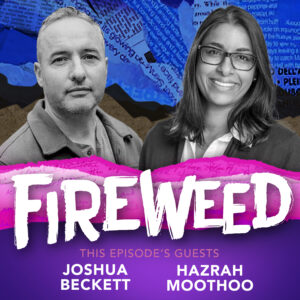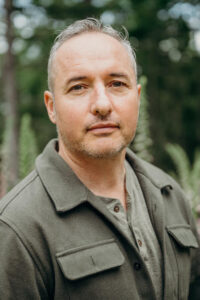Debunking the myths
Recreational cannabis has become ubiquitous, and with it, an entire encyclopedia of products and terms. Vapes, edibles, carbonated beverages, THC, CBD, terpenes — there’s a lot of lingo out there. In this episode, Bianca Rego speaks with Michael Chan and Hazrah Moothoo of BCIT’s Natural Health and Food Products Research Group to get a vocabulary lesson and a better sense of how the plant is being studied and brought to market. Then she’s joined by Josh Beckett — a master grower from Magi Cannabis on Saltspring Island, for a conversation about where this high-growth industry is headed next.
In this episode



Bianca Rego 00:00:07
Weed, pot, dope, chronic. Whatever you want to call it, cannabis use is blowing up. Legalization in Canada and in a number of US states has basically created a kind of cannabis renaissance. As tons of new cannabis products have rolled out weed shops have popped up everywhere, and it feels like everyone’s grandma and their dog are jumping on board the cannabis merry-go-round.
I myself don’t use it, because I have ADHD and, frankly, the whole thing seems intimidating. But even as a non-user, I notice that cannabis is often presented as a sort of miracle plant. It’s rumored to solve everything from glaucoma to cancer, depression to opioid addiction. At the same time, it’s making waves on the culinary front from gummies to brownies to craft beer. It’s hard to separate the facts from the “clouds of smoke” but as more and more of these cannabis products hit the market, it’s important that we’re looking at their potency, their effects, and their overall safety. This episode is all about separating the myths from the plant. Coming up, we’ll meet some experts from BCIT and a grower from Salt Spring Island who are doing just that.
I’m Bianca Rego, and welcome to Fireweed, a podcast brought to you by the British Columbia Institute of Technology. Fireweed is another plucky plant. In fact, it’s the first plant to grow back after a forest fire. On this show, we tap into one of the fireweed’s best qualities, its resilience. Each episode we explore stories of adaptation, and we talk to people who are changing their behavior, doing things differently, just to meet the future head on. If you have a great story of shifting your pattern to fit the new normal, email us at fireweed@bcit.ca.
Today we’re talking about the evolution of cannabis, a modest looking plant with a long history and a big reputation. And joining me today are Michael Chan and Hazrah Moothoo from BCIT’s Natural Health and Food Products Research Group, otherwise known as NRG. They helped develop the world’s first official method for analyzing cannabis. We’re going to find out more about that in just a minute. But, first, for consumers of cannabis out there, or even just for people who are curious, I thought since I had these experts in the house, we should start with some basic definitions. Michael, I always hear people talking about the THC content of cannabis. What is THC exactly?
Michael Chan 00:03:05
THC is tetrahydrocannabinol, and it is the main psychedelic compound that you would associate with cannabis, so it’s the most well studied of the compounds in cannabis. It is responsible for those psychedelic effects, so it’s a very active compound. And because it’s so well known, we standardize or report on THC content quite a bit whenever we’re discussing cannabis in terms of dosages and forms.
Bianca Rego 00:03:34
Okay, so what about CBD?
Michael Chan 00:03:36
CBD is cannabidiol. It is also a cannabinoid in cannabis plants. Now, CBD is not intoxicating. It is also quite predominant in cannabis. It’s not as high as your THC, but definitely in your hemp products, there is quite a bit of CBD in there. It also has a number of physiological effects, including pain reduction, sedation effects, but it doesn’t have those intoxicating effects, which is desirable in some cases.
Bianca Rego 00:04:07
So we hear quite a lot about CBD. It’s basically become an industry unto its own at this point. But what about CBDs lesser known cousin CBG?
Michael Chan 00:04:19
CBG is another cannabinoid. It’s in trace levels in most cases. The acid form of CBG, which is CBGA, is actually the precursor for THC and CBDA. So you could think of it as one of the first steps the plant uses to make the rest of these compounds. Because it’s at such low levels it hasn’t been as well studied because we haven’t had a lot of access to it and didn’t really look at it too deeply. But we’re finding that it appears to have a lot of biological effects similar to CBD.
Bianca Rego 00:04:52
So another term I sometimes hear thrown around is terpenes. What is a terpene?
Michael Chan 00:04:59
So terpenes is another class of compounds, and they’re not exclusive to, but they’re found in, the terpene class compounds are found in pretty much all plants, in a number of other natural products. They’re small molecules that are mainly responsible for your flavors and your aromas. They’re very aromatic compounds. They give you those kind of smells that you associate with cannabis, and then some of the flavors that are associated with different strains. You may see now that there’s a lot more information stating the exact levels of different terpenes that are present and the effects that the different terpenes have.
Bianca Rego 00:05:40
So there you go, folks. Cannabinoids and terpenes demystified. To sum it up a bit more simplistically, THC is for the psychoactive effects. CBD and CBG are for the physiological effects. And terpenes for that unmistakable bouquet. Now, this is a show that celebrates adaptability and resilience. And even though I don’t use it, I can’t help but feel a certain admiration for the cannabis plant. Here’s this versatile green plant that literally grows in ditches all over the world, contains all these different active components that can have quite profound effects on our bodies and minds. Michael Chan agrees.
Michael Chan 00:06:28
It is quite resilient. It can grow in different conditions, like the original indica and sativa breakdown. The different physical features are predominantly due to the environment that it grew in.
Bianca Rego 00:06:40
Indica and sativa, for those of you who may not know, are the two big strains of cannabis, reputed to have different qualities. Michael says their big difference arose because they adapted to different environments.
Michael Chan 00:06:55
So you have different types of leaves to just adapt to that kind of environment and allow it to grow and was able to survive. And throughout the years, despite regulations preventing it, putting it as a controlled substance and all that, it still maintained. It is a resilient plant, but it’s one that has beneficial uses and therefore we recognize it and helped it along a bit as well.
Bianca Rego 00:07:22
For the record, I myself have never helped a cannabis plant along, but I know plenty of people who have. And coming up later in the show, I’ll speak to an expert grower who’s made a living out of growing top flight, craft, cannabis for this legal market. But first, I asked Michael what he thought was next for applied research in the cannabis industry.
Michael Chan 00:07:43
As we’re looking at it we’re finding a lot more information and getting a lot more ideas on what’s in there, all the different chemicals in there, and the potential of these chemicals for using it. I do think there’s a lot of growth for this industry.
Bianca Rego 00:07:59
You are listening to Fireweed. My name is Bianca Rego, and you’ve just heard part of my conversation with Michael Chan of BCIT’s Natural Health and Food Products Research Group known as NRG. This applied research group looks at things like product quality, process improvement, and human health. Using basic and applied science along with state- of- the- art technology NRG offers applied research opportunities linked to graduate education, co- op placements, and industry projects. To learn more, check out bcit.ca/ applied- research, and keep listening.
Hazrah Moothoo works with Michael Chan at NRG. In fact, she’s the one with the key to the presumably locked cabinet where they keep all of the cannabis products. I asked her to tell me a bit more about the lab and what they do there.
Hazrah Moothoo 00:08:57
We are a chemistry lab that’s here to support the natural health and food product industry with challenges pertaining to testing, production, and processing, regulatory affairs, aspects that fall under quality control. So we take on industry projects with companies, but also conduct grant funded research to advance the knowledge base in these areas.
Bianca Rego 00:09:18
The cannabis industry, at least in British Columbia, was something of a Wild West for a long time. Then, medical use was legalized, so a few people got into growing it and experimenting with making edibles. But full legalization in Canada has meant that a number of players, big and small, have now gotten into the cannabis game commercially. Meanwhile, people like Hazrah and Michael are helping introduce scientifically valid standardization and more security for consumers when it comes to natural products like cannabis.
Hazrah Moothoo 00:09:53
One of our areas of expertise lies in the development of validated analytical methods. We target botanicals and foods where there’s a public health concern or if a plant is endangered or if there’s a sustainability issue. We also hold a Health Canada license to retain cannabis in our lab to support our research projects, and I’m in charge of managing this cannabis inventory here.
Bianca Rego 00:10:16
See? I told you she had the key to the cabinet.
Hazrah Moothoo 00:10:19
With respect to some of our cannabis projects we have previously published a validated testing method to determine the concentration of cannabinoids in cannabis plant material, and most recently expanded on this method to be able to test food formats, edibles, that include THC and CBD, so gummies, cookies, chocolate, dried fruit chips-
Bianca Rego 00:10:42
If someone wants to market a cannabis product, they can work with this lab to test it and make sure they understand its effects, its concentration, and so on.
Hazrah Moothoo 00:10:51
Our lab has participated in a lab proficiency program led by the US National Institute of Standards in Technology or NIST for short, where they’ve sent cannabis plant samples to various labs and labs use their in- house methods to test for levels of CBD and THC. So NIST compiles the data and determines the accuracy of the results.
Bianca Rego 00:11:15
I’m curious to know what your research tells us about how the different products measure up and how quickly they might affect people who try them.
Hazrah Moothoo 00:11:24
For products that are ingested, the effects felt would depend on how long it takes for the digestive process. So an hour or so. If you’re using a spray or using a slow dissolving lozenge, the uptake will be faster through the mouth’s salivary glands. Through inhalation, if you’re an experienced smoker, you have good lung capacity, say, the speed and efficiency of absorption will be faster, say minutes. The challenge lies when you expect an immediate effect or a slow gradual effect. It can be hard to regulate your dose if you’re trying different methods of consumption. And of course, each person reacts differently to products.
Bianca Rego 00:12:06
I don’t know about you, but I’m feeling more knowledgeable already, and I think that’s the really important thing here, is that people who decide to use cannabis have a way to know how much of it they’re getting. That way they can make a responsible choice. Here’s Hazrah again.
Hazrah Moothoo 00:12:23
In Canada, edible products are packaged as a single dose unit to contain 10 milligrams of THC. So chocolates are packaged as an individual square to contain 10 milligrams per square. Gummies, you might have two gummies in a pack to contain five milligrams of THC each. Or in a 355 mil bottle of lemon iced tea contains 10 milligrams of THC total. It’s about the consumer, like regulating how much THC they’re getting into their body.
Bianca Rego 00:12:52
It’s easy to mythologize cannabis, but Hazrah just sees it as another natural food product with potentially beneficial effects. She says that other natural food products are also enjoying a kind of renaissance right now.
Hazrah Moothoo 00:13:06
The natural health and food products market has seen their own explosion of new product formats. So you’ve got your Vitamin Waters, gummies containing echinacea, freeze dried fruits and vegetables, chewable iron tablets, probiotic capsules. I feel the consumers are already aware and have been exposed to these delivery formats so it’s easy in a way for the cannabis industry to introduce these products into the market. Also, the technology is there to be able to create these edible formats.
Bianca Rego 00:13:37
Hazrah, what would you say is the number one myth about cannabis that you, as someone who studies it closely, would like to debunk?
Hazrah Moothoo 00:13:48
Some may see the use of cannabis as a magic cure for all diseases. We need more research, and we are not close to understanding all the variables involved in the interactions within the body. So, as with any claims, I would advise caution. We’ve got to consider the strain of cannabis, the concentration levels within the plants, the dose administered. As such, the general use of cannabis to treat diseases as something that we have to take with a grain of salt and you have to look at your sources. So really we are in the early stages of cannabis research, and there’s a lot that we don’t know about the bio- availability of cannabis and interactions and pathways within the body.
Bianca Rego 00:14:31
That was Hazrah Moothoo of the BCIT Natural Health and Food Products Research Group where they test and analyze cannabis products and other natural food products.
So we’ve looked at some of the properties of the cannabis plant by talking to some of the folks involved in creating the system that measures and standardizes various cannabis products. But, remember, they study cannabis in a lab. I think with all this high tech talk, it’s easy to forget that cannabis is first and foremost a plant, and to grow it well, you need a serious green thumb. Farming anything is a tough gig, subject to wind, weather, and of course, in the case of cannabis, regulations. My next guest is from beautiful Salt Spring Island off BC’s West Coast.
Joshua Beckett 00:15:31
My name’s Joshua Beckett and I’m the master grower at Magi Cannabis. And we’re the only micro-cultivator on Salt Spring Island.
Bianca Rego 00:15:40
Is that a lot of responsibility?
Joshua Beckett 00:15:43
I created the license, and I’m the founder, so I take full responsibility. In many ways, the master grower is much like the master of a ship. If the ship sinks, they have to go down with it. That sounds a little bit grim. What I’m saying is that the master grower is ultimately the one responsible for the crops.
Bianca Rego 00:16:07
Josh has seen a lot of changes in the cannabis market over his lifetime, from local hippie growers with a few plants in the back field, to licensed medical marijuana systems, to decriminalized personal use, to our current legal recreational use market. I asked him to walk me through this evolution as a grower.
Joshua Beckett 00:16:27
I’m actually a second generation grower. My mom has always had done cannabis outdoor, and so I was always in the culture, and Salt Spring has a really long history relationship with it, so it’s always been around. And we were doing medical cannabis. Started out actually for my grandmother, she had Parkinson’s. We were producing a little bit of cannabis for her to help with that.
Bianca Rego 00:16:51
For the record, the Parkinson’s Foundation notes that while cannabis is currently being tested for Parkinson’s treatment, there isn’t conclusive scientific evidence that marijuana is beneficial in Parkinson’s Disease. But, anecdotally, Josh thinks it helped his grandma.
Joshua Beckett 00:17:0
It was really the only thing that could work since she had adverse reactions to l-DOPA, which is the synthetic dopamine that they give to Parkinson’s. So we did that, and then I took on a whole bunch of cancer patients for their palliative care and started growing for them. And then I started writing applications for companies that wanted to get into the legal cannabis game, and so I was aware of the transition to a recreational market pretty early on, like in 2014, 2015. I had been growing legally through the medical program since 2009. So I went through my security clearance, which is a very long process. It takes often six months to two years to go through, so I already had that in place before 2018 when the micro- cultivation licenses were offered for the first time. There’s over 300 micro-cultivators in Canada right now, so it was a natural fit for me to go for a micro-cultivation license.
Bianca Rego 00:18:17
I asked Josh to explain a bit about the various regulations and systems governing cannabis production and the sale in British Columbia right now. I was just curious to hear from a small grower explain how it all works.
Joshua Beckett 00:18:32
There’s two different regulatory systems that are at play there. One is the ACMPR personal use, or designate program, and there’s no guidelines on how it’s produced or what’s in it. And a lot of government bodies, police, will tell you that a lot of the diversion into the illicit market comes from, it could be completely unlicensed or could be medically licensed, but there’s no standards of cultivation, so there could be pesticides and so on. And the other is a licensed producer, which I am one of. Legal recreational cannabis is tested for everything. It’s probably the most tested agricultural product in Canada. But on the other side, some people say that recreational cannabis can be fairly dry and isn’t as good quality. And that’s changing. I’ve noticed that there’s really good quality cannabis available through the stores now, and that’s a big change from even last year. And the consumers are getting more educated.
Bianca Rego 00:19:37
I’m just wondering, how would you say cannabis compares to other commercially available recreational substances?
Joshua Beckett 00:19:43
Cannabis is very much like wine, isn’t it? In wine, they talk about the terroir and I would say in cannabis, an easier way to say would be the style. So what is the style? Like a Salt Spring style? That would be we’re using virgin coir.
Bianca Rego 00:20:00
In case you’re wondering, coir is the coconut husks that some growers use as a growing medium.
Joshua Beckett 00:20:06
We don’t reuse it, a single batch, and we flush with clean water for quite a while before we harvest. And then we whole plant dry in a cool room for a long time, two weeks, and then we hand trim everything that we sell. So it has that craft style. A lot of the small micros are doing that, at least the quality ones. And that’s what we would talk about when we talk about craft. You hear that word a lot, like craft, what does it mean? Those are sort of the things that go into a craft product.
Bianca Rego 00:20:42
So when you’re comparing it to alcohol, are there any negatives that are comparable?
Joshua Beckett 00:20:48
Absolutely, yes. Yeah, the negatives stem from addiction and from overuse and from unintentional overuse of cannabis happens all the time. And it results in what’s typically described as anxiety or dysphoria. It’s very important to understand dosage. And often people don’t really understand their tolerance, especially with edibles.
Bianca Rego 00:21:19
Where do you see cannabis’ role in society over the next decade, considering the stigma wears off and becomes more normalized?
Joshua Beckett 00:21:28
I think our society is getting more and more interested in health, and we want to reduce our reliance on alcohol and I think cannabis has an important part to play in that. So that’s one thing. I also think that cannabis naturally encourages environmentalism because I find that cannabis, it brings people closer to nature.
Bianca Rego 00:21:51
So with that in mind, what’s on the horizon? If you could look in the crystal ball?
Joshua Beckett 00:21:57
Well, we’re seeing psilocybin mushrooms come up. Is that going to play in with cannabis? Are they going to use the same rules? And just generally, the rise of psychedelics, and I think that cannabis has paved the way for that in society. That’s another trend, I think, to look out for. And we’re in the middle of a fentanyl crisis. So right there, that’s an important distinction to make. And especially the legal cannabis. It’s the safest substance. It has far less pesticides than organic food. In fact, I can’t even use organic molasses to feed my plants with because that molasses has pesticides that could be picked up in the cannabis. That’s the level to which I’m tested, one billionth of a part.
Bianca Rego 00:22:43
Wow. I want to thank my fantastic guests today. That was Josh Beckett at Magi Cannabis. You can hit them up on Twitter or on Instagram. I also want to thank Michael Chan and Hazrah Moothoo from BCIT’s Natural Health and Food Products Research Group, known as NRG.
If you enjoyed what you heard today, I hope you’ll check out the rest of the episodes of Fireweed, and share us with your friends. Help us spread the word about some of the incredible adaptation, ingenuity, and resourcefulness we have in this region and beyond.
Do you have thoughts on this episode or a story to share? Email us at fireweed@bcit.ca or DM us on Instagram @lifeatBCIT with your tales of resilience. Thank you for listening to Fireweed. I’m Bianca Rego, and I’ll see you all next episode, when we’re talking about sustainable flight.